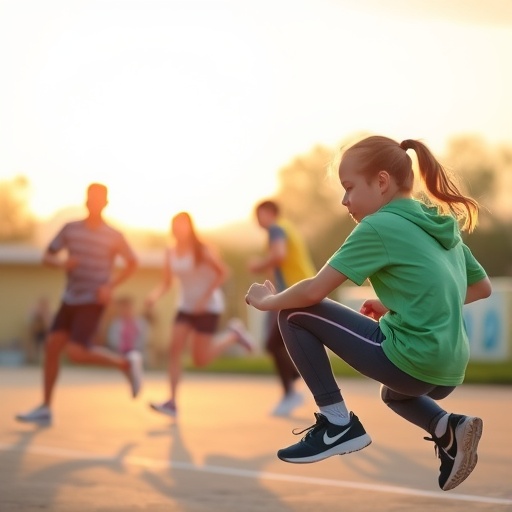Recent research has increasingly highlighted the significant role that physical activity plays in the mental well-being of adolescents, particularly those diagnosed with Attention Deficit Hyperactivity Disorder (ADHD). A groundbreaking study by Liu et al. delves into this topic, exploring the intricate relationship between moderate-to-vigorous physical activity (MVPA) and psychological ill-being among youths with ADHD. The insights unveiled through their research could have transformative implications for treatment and intervention strategies in this demographic.
Physical activity is not merely a means of enhancing physical health; its effects extend deeply into the realms of psychological wellness. For adolescents, especially those facing the challenges associated with ADHD, the benefits of engaging in regular MVPA are manifold. Empirical evidence suggests that increased physical activity is associated with reductions in symptoms such as hyperactivity and impulsivity, ultimately leading to improved emotional regulation and general happiness. This research thus endeavors to understand how the practice of MVPA intersects with the psychological experiences of adolescents with ADHD, contributing to a more nuanced understanding of this group’s health needs.
One of the pivotal aspects of the Liu et al. study is the focus on physical self-concept—how individuals perceive their own physical attributes and abilities—and its mediating role in the relationship between MVPA and psychological ill-being. The concept of self-concept is crucial in adolescent development, serving as a lens through which young individuals assess their capabilities and value. For adolescents with ADHD, a positive physical self-concept can foster resilience against the mental health challenges they may face, thus underscoring the necessity of nurturing a strong self-image through supportive physical activity frameworks.
Involving adolescents in MVPA has shown a plethora of benefits, beyond just physical fitness. Activities such as team sports, martial arts, dance, and even daily exercises can at once boost their physical health and contribute positively to their psychological state. When adolescents with ADHD engage in these activities regularly, they not only enhance their physical capabilities but also begin to internalize a more positive self-image, which can counteract feelings of inadequacy or low self-esteem often experienced by this group.
Moreover, the communal aspect of participating in physical activities, especially team sports, serves as a critical social outlet for adolescents with ADHD. This interaction facilitates the development of social skills and the formation of meaningful relationships, which are essential components of psychological well-being. The social dynamics inherent in group physical activities can help mitigate feelings of isolation that some adolescents may experience, thus referencing the interconnectedness between physical activity and social interaction in promoting mental health.
Another vital finding within Liu et al.’s research is that the intensity and type of physical activity matter. Moderate-to-vigorous physical activities are particularly effective due to the energy expenditure required and the subsequent release of neurotransmitters that positively influence mood and cognition. The study emphasizes integrating diverse forms of MVPA into the lives of adolescents with ADHD, allowing them to discover activities that they enjoy, thereby promoting consistency and commitment to an active lifestyle.
Parents, educators, and health professionals play a crucial role in facilitating access to physical activities for adolescents with ADHD. By promoting environments that encourage active participation, stakeholders can help establish routines that incorporate regular MVPA. This could include using school curriculums that emphasize physical education, community programs that cater to youth sports, or even family-based activities that elevate the importance of movement and social interaction within everyday life.
The findings from Liu et al. contribute significantly to the understanding of ADHD management strategies. They bolster the argument for integrated approaches that combine therapeutic interventions and physical activity regimes aimed at improving the quality of life for adolescents with ADHD. The research aligns with broader public health recommendations that advocate for an increase in physical activity among youth populations, particularly in light of the growing concerns surrounding childhood obesity and mental health crises.
Furthermore, understanding the relationship between MVPA, self-concept, and psychological well-being can lead to more tailored therapeutic approaches. Mental health professionals may consider recommending physical activity as a complementary treatment option alongside traditional therapy methods. This interdisciplinary approach can address both the psychological and physical dimensions of health, fostering comprehensive support for adolescents with ADHD.
Ultimately, Liu et al.’s findings stimulate an essential dialogue on the importance of physical health in mental health outcomes for adolescents. As society grapples with rising mental health concerns and the pervasive impacts of ADHD, integrating physical activity into treatment regimens emerges as a vital component. This research accentuates the transformative potential of physical activity—not just as a means for improved physical health, but also as a pathway to enhanced emotional and psychological stability for adolescents facing ADHD.
As we advance into an age that increasingly values holistic health approaches, the relevance of studies like that of Liu et al. cannot be overstated. Their findings advocate for a societal shift towards recognizing the intricacies of mental and physical health interdependence, especially among vulnerable populations like adolescents with ADHD. Encouragingly, these insights pave the way for future research to further elucidate effective strategies that can empower this group, ultimately fostering healthier, more fulfilling lives.
Through this exploration of the complex roles physical activity and self-concept play in shaping the psychological experiences of adolescents with ADHD, Liu et al.’s work emerges as a notable contribution to both academic discourse and practical applications. By harnessing the power of moderate-to-vigorous physical activity, there exists a remarkable opportunity to uplift and enhance the lives of those burdened by ADHD, ushering in a more comprehensive understanding of health and well-being during a crucial developmental stage.
The implications of this research extend beyond just individual transformations; they beckon an urgency for community awareness and systemic changes that prioritize physical activity like never before. As we move forward, it becomes imperative that researchers, clinicians, and policymakers collaborate to create environments that cultivate not just active bodies but also thriving minds for all adolescents, particularly those with ADHD.
In conclusion, Liu and colleagues provide a vital message: MVPA is not just a contribution to physical health but a crucial pillar supporting the intricate architecture of psychological well-being in adolescents facing ADHD. As we harness and disseminate these findings, we must commit to fostering a future where every adolescent has the opportunity to engage in physical activities that uplift and empower them holistically.
Subject of Research: The relationship between moderate-to-vigorous physical activity, psychological well-being, and physical self-concept in adolescents with ADHD.
Article Title: Moderate-to-Vigorous Physical Activity and Psychological Ill-Being in Adolescents With ADHD: The Mediating Effects of Physical Self-concept.
Article References:
Liu, C., Yang, Y., Arbour-Nicitopoulos, K. et al. Moderate-to-Vigorous Physical Activity and Psychological Ill-Being in Adolescents With ADHD: The Mediating Effects of Physical Self-concept.
J Autism Dev Disord (2025). https://doi.org/10.1007/s10803-025-07052-y
Image Credits: AI Generated
DOI: 10.1007/s10803-025-07052-y
Keywords: ADHD, Physical Activity, Adolescent Mental Health, Physical Self-Concept, Psychological Well-Being.
Tags: ADHD and physical activitybenefits of moderate-to-vigorous physical activityemotional regulation through exerciseenhancing happiness through exerciseimportance of regular physical activityinterventions for ADHD adolescentsmental well-being in adolescentsphysical self-concept and mental healthpsychological experiences of ADHD individualspsychological wellness in ADHD youthsreducing hyperactivity symptomstransformative implications for ADHD treatment





